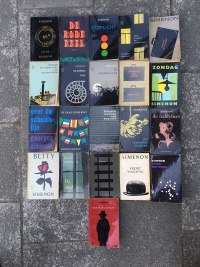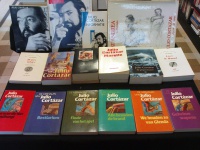Dutch-language literature
From The Art and Popular Culture Encyclopedia
| Revision as of 11:32, 16 July 2023 Jahsonic (Talk | contribs) ← Previous diff |
Revision as of 11:33, 16 July 2023 Jahsonic (Talk | contribs) Next diff → |
||
| Line 1: | Line 1: | ||
| [[Image:Collection of 21 Simenon romans durs bought at Panoply books, Antwerp, May 2020.jpg|thumb|right|200px|Collection of 21 Dutch translations of [[The 'romans durs' by Simenon|'romans durs']] by [[Georges Simenon]], in the [[Zwarte Beertjes]] collection, cover designs by [[Dick Bruna]]. | [[Image:Collection of 21 Simenon romans durs bought at Panoply books, Antwerp, May 2020.jpg|thumb|right|200px|Collection of 21 Dutch translations of [[The 'romans durs' by Simenon|'romans durs']] by [[Georges Simenon]], in the [[Zwarte Beertjes]] collection, cover designs by [[Dick Bruna]]. | ||
| - | <br><small>Photo © [[JWG]]</small>]] {| class="toccolours" style="float: left; margin-left: 1em; margin-right: 2em; font-size: 85%; background:#c6dbf7; color:black; width:30em; max-width: 40%;" cellspacing="5" | + | <br><small>Photo © [[JWG]]</small>]] |
| + | [[Image:Cortazar boekenuitstalling.JPG |thumb|200px|Bookshop display of [[Julio Cortázar]] books]] | ||
| + | {| class="toccolours" style="float: left; margin-left: 1em; margin-right: 2em; font-size: 85%; background:#c6dbf7; color:black; width:30em; max-width: 40%;" cellspacing="5" | ||
| | style="text-align: left;" | | | style="text-align: left;" | | ||
| "[[Ik ben een God in 't diepst van mijn gedachten]]" | "[[Ik ben een God in 't diepst van mijn gedachten]]" | ||
Revision as of 11:33, 16 July 2023

Photo © JWG

|
Related e |
|
Featured: |
Dutch-language literature comprises all writings of literary merit written through the ages in the Dutch language, a language which currently has around 23 million native speakers. Dutch-language literature is the produce of Netherlands, Belgium, Suriname, the Netherlands Antilles and of formerly Dutch-speaking regions, such as French Flanders, South Africa, and Indonesia. The Dutch East Indies, as Indonesia was called under Dutch colonization, spawned a separate subsection in Dutch-language literature. Conversely, Dutch-language literature sometimes was and is produced by people originally from abroad who came to live in Dutch-speaking regions, such as Anne Frank and Kader Abdolah. In its earliest stages, Dutch-language literature is defined as those pieces of literary merit written in one of the Dutch dialects of the Low Countries. Before the 17th century, there was no unified standard language; the dialects that are considered Dutch evolved from Old Frankish. A separate Afrikaans literature started to emerge during the 19th century, and it shares the same literary roots as contemporary Dutch, as Afrikaans evolved from 17th-century Dutch. The term Dutch literature may either indicate in a narrow sense literature from the Netherlands, or alteratively Dutch-language literature (as it is understood in this article).
Until the end of the 11th century, Dutch literature, like literature elsewhere in Europe, was almost entirely oral and in the form of poetry. In the 12th and 13th century, writers starting writing chivalric romances and hagiographies for noblemen. From the 13th century, literature became more didactic and developed a proto-national character, as it was written for the bourgeoisie. With the close of the 13th century a change appeared in Dutch literature. The Flemish and Hollandic towns began to prosper and a new sort of literary expression began. Around 1440, literary guilds called rederijkerskamers ("Chambers of Rhetoric") arose which were usually middle-class in tone. Of these chambers, the earliest were almost entirely engaged in preparing mysteries and miracle plays for the people. Anna Bijns (c. 1494–1575) is an important figure who wrote in modern Dutch. The Reformation appeared in Dutch literature in a collection of Psalm translations in 1540 and in a 1566 New Testament translation in Dutch. The best-known of all Dutch writers is the Catholic playwright and poet Joost van den Vondel (1587–1679).
During the late eighteenth and early nineteenth century, the Low Countries had gone through major political upheaval. The most prominent writers were Willem Bilderdijk (1756–1831), Hiëronymus van Alphen (1746–1803), and Rhijnvis Feith (1753–1824). Piet Paaltjens (ps. of François Haverschmidt, 1835–1894) is one of the very few readable nineteenth-century poets, representing in Dutch the Romantic vein exemplified by Heine. A new movement called Tachtigers or "Movement of (Eighteen-)Eighty", after the decade in which it arose. One of the most important historical writers of the 20th century was Johan Huizinga, who is known abroad and translated in different languages and included in several great books lists. During the 1920s, a new group of writers who distanced themselves from the ornate style of the Movement of 1880 arose, led by Nescio (J.H.F. Grönloh, 1882–1961). During WW II, influential writers included Anne Frank (whose diary was published posthumously) died in a German concentration camp, as did crime fiction writer, journalist and poet Jan Campert. Writers who had lived through the atrocities of the Second World War reflected in their works on the changed perception of reality. Obviously many looked back on their experiences the way Anne Frank had done in her Diary, this was the case with Het bittere kruid (The bitter herb) of Marga Minco, and Kinderjaren (Childhood) of Jona Oberski. The renewal, which in literary history would be described as "ontluisterend realisme" (shocking realism), is mainly associated with three authors: Gerard Reve, W.F. Hermans and Anna Blaman. Reve and Hermans are often cited together with Harry Mulisch as the "Big Three" of Dutch postwar literature.
See also
- The Dedalus Book of Dutch Fantasy (1994)
- Dutch folklore
- Dutch media
- Canon of Dutch Literature
- Belgian literature
- Flemish literature
- Afrikaans literature

